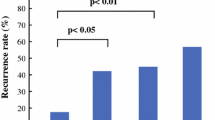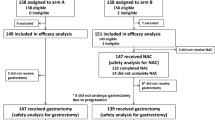Abstract
Background
Curative gastrectomy followed by adjuvant S-1 chemotherapy for 12 months is one of the standard treatments for patients with pathological stage (p-stage) II or III gastric cancer. Although some patients have difficulty maintaining compliance with adjuvant S-1, the risk factors for poor compliance are unknown.
Methods
We retrospectively analyzed the data of patients at 21 institutions who underwent curative gastrectomy followed by adjuvant S-1 for p-stage II or III gastric cancer. Patients who had a recurrence within 12 months after surgery were excluded from the analysis. Associations between clinicopathological factors and both 12-month compliance and the cumulative continuation rate of S-1 were analyzed.
Results
Of 359 patients, 252 (70.2%) continued adjuvant S-1 until 12 months after surgery. Older age (>65 years) and postoperative infectious complications (Clavien–Dindo grade III or higher) were significantly correlated with low compliance with S-1 for 12 months (p = 0.008 and p = 0.042). These two factors also showed significant associations with low cumulative continuation rate (log-rank p < 0.001 and p = 0.018). Continuation rates at 12 months after surgery in patients aged ≤60 years, 61–65, 66–70, 71–75, and 76–80 years were 81.5, 75.9, 65.4, 58.7, and 62.9%, respectively. Type of gastrectomy or body weight loss at 1 month after surgery did not affect either 12-month compliance or the cumulative continuation rate of S-1.
Conclusions
Older age, especially over 65 years, and postoperative infectious complications were independent risk factors for poor compliance with adjuvant S-1 chemotherapy for gastric cancer.


Similar content being viewed by others
References
Sakuramoto S, Sasako M, Yamaguchi T, et al. Adjuvant chemotherapy for gastric cancer with S-1, an oral fluoropyrimidine. N Engl J Med. 2007;357(18):1810–20.
Davis JL, Selby LV, Chou JF, et al. Patterns and predictors of weight loss after gastrectomy for cancer. Ann Surg Oncol. 2016;23(5):1639–45.
Takiguchi S, Miyazaki Y, Takahashi T, et al. Impact of synthetic ghrelin administration for patients with severe body weight reduction more than 1 year after gastrectomy: a phase II clinical trial. Surg Today. 2016;46(3):379–85.
Kim JW, Jung SY, Cho JW, Kim BC, Chung KS, Yang DH. Postoperative body mass index changes in gastric cancer patients according to reconstruction type: effectiveness of long jejunal bypass on weight loss in obese patients after distal gastrectomy. Indian J Surg. 2014;76(3):187–92.
Aoyama T, Yoshikawa T, Shirai J, et al. Body weight loss after surgery is an independent risk factor for continuation of S-1 adjuvant chemotherapy for gastric cancer. Ann Surg Oncol. 2013;20(6):2000–6.
Aoyama T, Kawabe T, Fujikawa H, et al. Loss of lean body mass as an independent risk factor for continuation of S-1 adjuvant chemotherapy for gastric cancer. Ann Surg Oncol. 2015;22(8):2560–66.
Aoyama T, Yoshikawa T, Hayashi T, et al. Risk factors for 6-month continuation of S-1 adjuvant chemotherapy for gastric cancer. Gastric Cancer. 2013;16(2):133–39.
Japanease Gastric Cancer Association. Japanese classification of gastric carcinoma: 3rd English edition. Gastric Cancer. 2011;14(2):101–12.
Japanease Gastric Cancer Association. Japanese gastric cancer treatment guidelines 2010 (ver. 3). Gastric Cancer. 2011;14(2):113–23.
Clavien PA, Sanabria JR, Strasberg SM. Proposed classification of complications of surgery with examples of utility in cholecystectomy. Surgery. 1992;111(5):518–26.
Katayama H, Kurokawa Y, Nakamura K, et al. Extended Clavien-Dindo classification of surgical complications: Japan Clinical Oncology Group postoperative complications criteria. Surg Today. 2016;46(6):668–85.
Jeong JH, Ryu MH, Ryoo BY, et al. Safety and feasibility of adjuvant chemotherapy with S-1 for Korean patients with curatively resected advanced gastric cancer. Cancer Chemother Pharmacol. 2012;70(4):523–29.
Tsujimoto H, Horiguchi H, Hiraki S, et al. Tolerability of adjuvant chemotherapy with S-1 after curative resection in patients with stage II/III gastric cancer. Oncol Lett. 2012;4(5):1135–39.
Yamanaka T, Matsumoto S, Teramukai S, Ishiwata R, Nagai Y, Fukushima M. Safety evaluation of oral fluoropyrimidine S-1 for short- and long-term delivery in advanced gastric cancer: analysis of 3,758 patients. Cancer Chemother Pharmacol. 2008;61(2):335–43.
Sierzega M, Kolodziejczyk P, Kulig J. Impact of anastomotic leakage on long-term survival after total gastrectomy for carcinoma of the stomach. Br J Surg. 2010;97(7):1035–42.
Kubota T, Hiki N, Sano T, et al. Prognostic significance of complications after curative surgery for gastric cancer. Ann Surg Oncol. 2014;21(3):891–98.
Yoo HM, Lee HH, Shim JH, Jeon HM, Park CH, Song KY. Negative impact of leakage on survival of patients undergoing curative resection for advanced gastric cancer. J Surg Oncol. 2011;104(7):734–40.
Saito T, Kurokawa Y, Miyazaki Y, et al. Which is a more reliable indicator of survival after gastric cancer surgery: postoperative complication occurrence or C-reactive protein elevation? J Surg Oncol. 2015;112(8):894–99.
Funding
No financial support was received for this study.
Author information
Authors and Affiliations
Corresponding author
Ethics declarations
Disclosures
Kotaro Yamashita, Yukinori Kurokawa, Kazuyoshi Yamamoto, Masashi Hirota, Ryohei Kawabata, Jota Mikami, Toru Masuzawa, Shuji Takiguchi, Masaki Mori, and Yuichiro Doki have no conflicts of interest or financial ties to disclose.
Rights and permissions
About this article
Cite this article
Yamashita, K., Kurokawa, Y., Yamamoto, K. et al. Risk Factors for Poor Compliance with Adjuvant S-1 Chemotherapy for Gastric Cancer: A Multicenter Retrospective Study. Ann Surg Oncol 24, 2639–2645 (2017). https://doi.org/10.1245/s10434-017-5923-2
Received:
Published:
Issue Date:
DOI: https://doi.org/10.1245/s10434-017-5923-2




